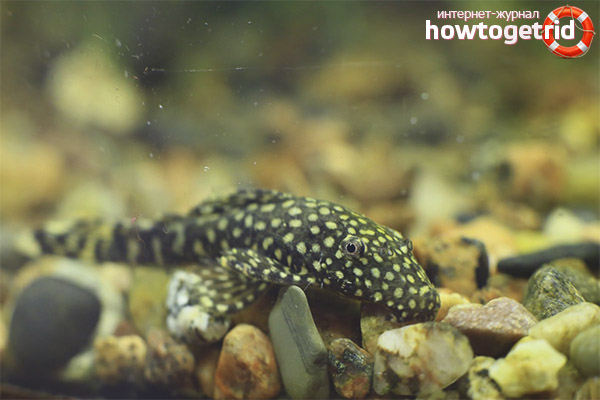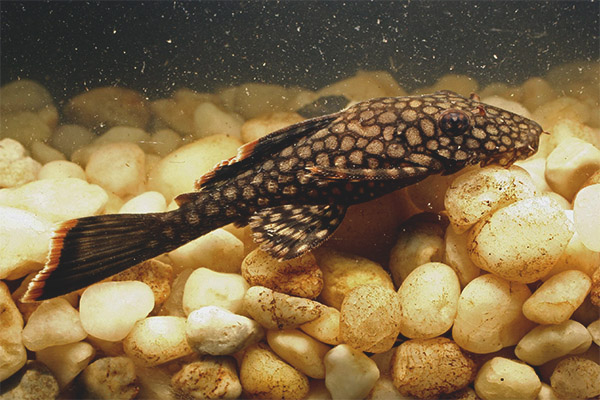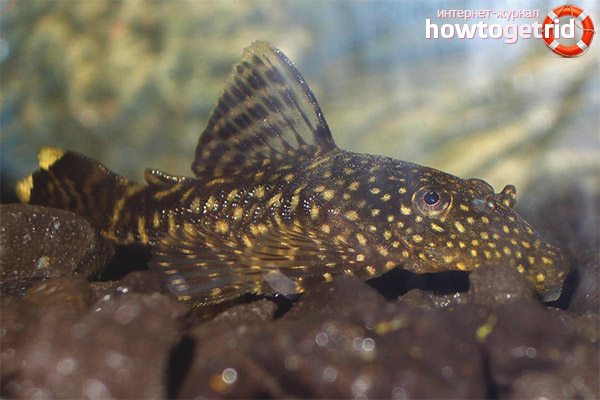The content of the article
Common ancistrus or Ancistrus dolichopterus, also called catfish suckers, is actually from South America and is found in the Amazon. They live in the waters of large rivers and a wide variety of swamps. The most common among them are representatives of the ancitrus ordinary. Antsistrusy were imported to the USSR in the mid-70s of the 20th century.
Description
These fish are distinguished by an elongated, flattened body, the length of which ranges from 10 to 14 cm, and is sometimes capable of reaching large sizes. It is covered with a strong shell, which protects this aquarium inhabitant from possible damage by external factors, which consists of bone plates. The trunk of an elongated shape is decorated with pectoral, ventral, dorsal and small anal fat fins. The head is quite large.
Males are larger and more slender with peculiar leathery outgrowths in the head, resembling horns. They are smaller and have no horns.
Neighborhood with other residents
These catfish perfectly coexist with other types of aquarium inhabitants. But they are not completely harmless. They can start chasing their neighbors, pestering them, and even causing traumatic injuries.
Their sharing with sluggish species, for example, all their favorite gold, is contraindicated. Scaleless fishes are also not suitable as cohabitants for antsitrus, for the reason that there is a high risk of damage to the skin of the latter. Large and aggressive fish in a joint tank is also not the best option. With them, bloody fights may occur.
Life in aquarium conditions
Simple antsistrusy or sticky - perfectly complement any freshwater aquariums. They feed by absorbing algae in huge amounts. Therefore, the tank must be provided with sufficient quantities.
Nevertheless, they grow at home sometimes to quite impressive sizes of real river monsters. Aquarium catfish Ancistrus remain, as a rule, small in size and rarely reach 15 centimeters.For this reason, they are very appropriate as aquarium cleaners, unlike other members of their own species.
Antsistrus aquarium inhabitants need a spacious tank. In addition, they are quite active, they need enough space to have a place for shelter and food. Almost all the time they spend in search of food, follow meals and then again in search. For this reason, they emit many products of their own life, which leads to water pollution. For aquariums, where ancistrus lives, it is necessary to equip them with powerful filters. The life expectancy of these fish is about 7 years, but, as a rule, they live much less.
Under natural conditions, somiki Ancistrus spend all their time hiding in any available shelters, snags and caves. In the tank where they are contained, it is important to create conditions as close as possible to natural ones. This can be done by installing ceramic pots, coconuts, and large snags in the aquarium, which will become suitable shelter for antsistrus if necessary.
Choosing filters, it is necessary to give preference to the internal.To enhance its effectiveness, you can use a simple washcloth, which will help increase the efficiency of water purification. But if possible, still the best option is to install an external, canister filter.
As for the lighting, then in no case should it be bright. But in order for the aquarium to have good vegetation, which is simply necessary for the ancistrus, it needs to be illuminated. For this reason, it is worthwhile to arrange the lighting so that it appears and disappears periodically.
Antsistrus - the fish is quite unpretentious. They are able to adapt to any parameters of water. The main thing is that it is clean and saturated with oxygen. Optimum conditions of maintenance: at a temperature of 22 to 28 degrees, acidity - from 6 to 7.5 and hardness up to 20 dH.
The construction of the soil is that it consists of sand with the addition of fine gravel. Its layer should be about 4 cm.
Nutrition

Antsistrusy love to eat and do it all the time. They need a lot of food. Their diet consists of plant foods, food with spirulina in the form of tablets is perfect.This option does not become limp in water for a long time, and has an attractive aroma for antsistrusov. You can supplement their food with vegetables, which will make the diet of these fish more diverse. As a top dressing you can use zucchini, cucumbers and watercress.
Important! Remove leftovers from the aquarium in a timely manner to keep the water clean.
If catfish Ancistrusov have a desire to breed, then you must enter into the diet of frozen food. As a live feed, you can use the choke and bloodworms. These are the only delicacies that will suit this type for sure. It is important that feed, which, as a rule, sink to the bottom, was freely available. Otherwise, their ancistrus may simply not be noticed.
To catfish have the opportunity to escape for some time, digesting food, you must use a snag. In addition, representatives of this species receive enzymes for digesting food by scraping pieces of wood. With such décor in an aquarium, they will always be in good health and feel comfortable. Ideally, the bottom of the tank should contain a few koryag.
Breeding
Common ancistrus reproduce beautifully in captivity. If the tank is properly equipped, they will not need additional assistance. It is important that there are more female representatives than males, especially if the tank is small. In another situation, the males may show aggression towards each other. After all, antsistrusam tend to protect their own territory. In addition, they are able to eat the eggs of their competitors.
In preparation for the breeding of common ancistrus, it is necessary to determine the sex of individuals contained in the aquarium. Male and female are distinguished by size. Also, men have horns on their heads. Selected individuals are placed in a separate aquarium with suitable water parameters; this will facilitate spawning. In principle, they can breed in any conditions, but suitable ones will make the process more efficient.
When males are ready for breeding, they begin to engage in the arrangement of shelter, clearing and protecting it. When the right place is ready, the males begin to attract ladies with the help of tail strokes. After examining the selected shelter, females lay eggs inside it.Ankistrus ikriny large, bright orange, hang in clusters.
After spawning females, the male is engaged in insemination of calf, after which it drives away the future mom and is engaged in the protection of future babies. Therefore, after the female laid eggs, it is deposited in another tank.
Ripening of eggs lasts from a week to 10 days. Then fry appear. Males are engaged in their protection until the little ones begin to swim. As soon as they swam, the parent is required to be resettled.
During the first days the fry are fed with ciliates and spirulina. After some time, shrimps and vegetable foods are added to the ration, which feed on adult santfish antsistrus.
Somik antsistrus - quite spectacular and very unpretentious to the content in the home aquarium fish. For this reason, they are so popular today among novice aquarists. In addition, Antsistrus is a natural “cleaner” of the tank, which makes life easier for its owner. Among other things, they are also excellent neighbors for their relatives.
Nutrition Antsistrusov simple enough and affordable for any owner.However, they require that they be kept in a clean and sufficiently sized aquarium. With all the unpretentiousness of this type, it is necessary to ensure their accommodation with minimal care and high-quality filtration.
Video: catfish antsistrusy (sticky)












To send